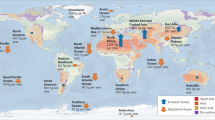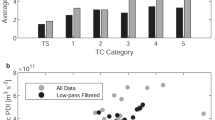Abstract
Aerosols may affect climate through the absorption and scattering of solar radiation and, in the case of large dust particles, by interacting with thermal radiation1,2,3. But whether atmospheric temperature responds significantly to such forcing has not been determined; feedback mechanisms could increase or decrease the effects of the aerosol forcing. Here we present an indirect measure of the tropospheric temperature response by explaining the ‘errors’ in the NASA/Goddard model/data-assimilation system. These errors, which provide information about physical processes missing from the predictive model, have monthly mean patterns that bear a striking similarity to observed patterns of dust over the eastern tropical North Atlantic Ocean. This similarity, together with the high correlations between latitudinal location of inferred maximum atmospheric heating rates and that of the number of dusty days, suggests that dust aerosols are an important source of inaccuracies in numerical weather-prediction models in this region. For the average dust event, dust is estimated to heat the lower atmosphere (1.5–3.5 km altitude) by ∼0.2 K per day. At about 30 dusty days per year, the presence of the dust leads to a regional heating rate of ∼6 K per year.
This is a preview of subscription content, access via your institution
Access options
Subscribe to this journal
Receive 51 print issues and online access
$199.00 per year
only $3.90 per issue
Buy this article
- Purchase on Springer Link
- Instant access to full article PDF
Prices may be subject to local taxes which are calculated during checkout




Similar content being viewed by others
References
Charlson, R. et al. Climate forcing by anthropogenic aerosols. Science 255, 423–430 (1992).
Penner, J. E. et al. Quantifying and minimizing uncertainty of climate forcing by anthropogenic aerosols. Bull. Am. Meteorol. Soc. 75, 375–400 (1994).
Tegen, I., Lacis, A. A. & Fung, I. The influence of mineral aerosols from disturbed soils on the global radiation budget. Nature 380, 419–422 (1996).
Arking, A. The radiative effects of clouds and their impact on climate. Bull. Am. Meteorol. Soc. 72, 795–813 (1991).
Lindzen, R. S. Some coolness concerning global warming. Bull. Am. Meteorol. Soc. 71, 288–299 (1990).
Moulin, C., Lambert, C. E., Dulac, F. & Dayan, U. Control of atmospheric export of dust from North Africa by the North Atlantic Oscillation. Nature 387, 691–694 (1997).
Prospero, J. M. et al. Temporal variability of summertime ozone and aerosols in the free troposphere over the eastern North Atlantic. Geophys. Res. Lett. 22, 2925–2928 (1995).
Husar, R. B., Prospero, J. M. & Stowe, L. L. Characterization of tropospheric aerosols over the oceans with the NOAA advanced very high resolution radiometer optical thickness operational product. J. Geophys. Res. 102, 16889–16910 (1997).
Daley, R. Atmospheric Data Analysis (Cambridge Univ. Press, New York, (1991)).
Bloom, S. S., Takacs, L. L., da Silva, A. M. & Ledvina, D. Data assimilation using incremental analysis updates. Mon. Weath. Rev. 124, 1256–1271 (1996).
Schubert, S. et al. An assimilated data set for Earth Science applications. Bull. Am. Meteorol. Soc. 74, 2331–2342 (1993).
Jankoviak, I. & Tanre, D. Satellite climatology of Saharan dust outbreaks: Method and preliminary results. J. Clim. 15, 646–656 (1992).
Prospero, J. M. & Nees, R. T. Impact of the North African drought and El Niño on the mineral dust in the Barbados trade winds. Nature 320, 735–738 (1986).
Westphal, D. L., Toon, O. B. & Carlson, T. N. Atwo-dimensional numerical investigation of the dynamics and micro-physics of Saharan dust storms. J. Geophys. Res. 92, 3027–3049 (1987).
Rossow, R. B. & Schiffer, R. A. ISCCP cloud data products. Bull. Am. Meteorol. Soc. 72, 2–20 (1991).
Asnani, G. C. Tropical Meteorology (Indian Inst. of Tropical Meteorology, Pune, (1993)).
Pick, C. Transport of Desert Aerosols and their Influence on Local Temperature and Motion.Thesis, Tel Aviv Univ.((1991)).
Eubank, R. L. Spine Smoothing and Non-parametric Regression (Dekker, New York, (1988)).
Carlson, T. N. & Benjamin, S. G. Radiative heating rates for Saharan dust. J. Atmos. Sci. 37, 193–213 (1980).
Karyampudi, V. M. A Numerical Study of the Evolution, Structure and Energetics of the Saharan Air Layer.Thesis (Pennsylvania State Univ., (1986)).
Joseph, J. H. in Aerosols and their Climatic Effects (eds Gerber, H. E. & Deepak, A.) 215–226 (Deepak, Hampton, VA, (1984)).
Alpert, P. & Ganor, E. Ajet-stream associated heavy dust storm in the western Mediterranean J.Geophys. Res. 98, 7339–7349 (1993).
Tanré, D., Kaufman, Y. J., Herman, M. & Matoo, S. Remote sensing of aerosol over oceans using the EOS-MODIS spectral radiances. J. Geophys. Res. 102, 16971–16988 (1997).
Kaufman, Y. J. et al. Remote sensing of tropospheric aerosol over land from EOS moderate resolution imaging spectroradiometer. J. Geophys. Res. 102, 17051–17068 (1997).
Reale, A. L., Chalfant, M. W., Wagoner, R. V., Gardner, T. J. & Casey, L. W. TOVS Operational Sounding Upgrades 1990–1992. NOAA Tech. Rep. NESDIS 76 (US Dept of Commerce, NOAA NESDIS, Washington DC, (1994)).
Acknowledgements
This study was supported by the US–Israel Binational Science Foundation. During some of this work, P.A. held a National Research Council–NASA/GSFC research associateship. Our thanks to Y. Banjamini for statistical help with Fig. 4.
Author information
Authors and Affiliations
Corresponding author
Rights and permissions
About this article
Cite this article
Alpert, P., Kaufman, Y., Shay-El, Y. et al. Quantification of dust-forced heating of the lower troposphere. Nature 395, 367–370 (1998). https://doi.org/10.1038/26456
Received:
Accepted:
Issue Date:
DOI: https://doi.org/10.1038/26456
This article is cited by
-
Climatology of the spring subtropical jet stream over the Middle East and its effect on the synoptic characteristics of dust systems over the northern Arabian Peninsula
Arabian Journal of Geosciences (2023)
-
Long-term climatology and spatial trends of absorption, scattering, and total aerosol optical depths over East Africa during 2001–2019
Environmental Science and Pollution Research (2022)
-
Dust induced radiative perturbations during an episode of long-range dust transport over Delhi, India: a high-resolution regional NWP model study
Meteorology and Atmospheric Physics (2021)
-
The Reduction of the Global Irradiance Due to the Asian Dust Aerosols (PM10) Estimated by the Observed Data in the Dust Source Region of Erdene in Mongolia
Asia-Pacific Journal of Atmospheric Sciences (2019)
-
Dust aerosol properties and radiative forcing observed in spring during 2001–2014 over urban Beijing, China
Environmental Science and Pollution Research (2016)
Comments
By submitting a comment you agree to abide by our Terms and Community Guidelines. If you find something abusive or that does not comply with our terms or guidelines please flag it as inappropriate.



